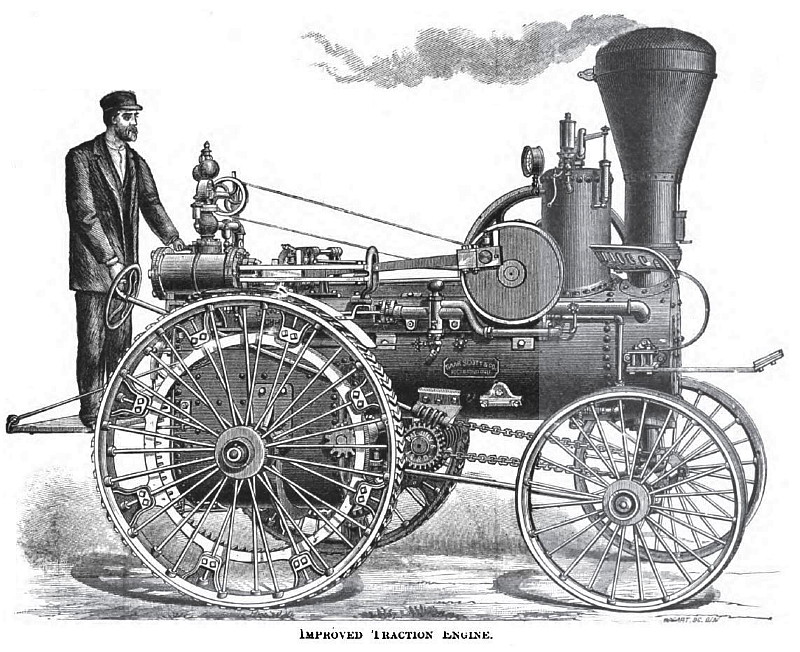|
Title: |
1882 Article-Gaar, Scott & Co., Steam Traction Engine |
|
Source: |
American Machinist, V5, 11 Feb 1882, pg. 05 |
|
Insert Date: |
10/28/2018 9:39:08 PM |
Improved Traction Engine
Within the past few years the use of traction engines for farm purposes, particularly in the Western States, has become comparatively common, and to meet the increasing demand their manufacture has developed an industry of considerable importance.
In the construction of these engines many difficulties have to be met, and the meeting and surmounting these difficulties, to the extent that has been done, has unquestionably required the exercise of no small degree of engineering skill and ability. It is evident that such machines, as a whole, must be of considerable strength, and used as they are largely in connection with a threshing machine, it is obvious that they must not only be able to draw heavy loads—such as the separator and water tank—up hills and over rough, uneven ground, but that they must possess the quality of elasticity in a remarkable degree. It must also, under all circumstances, be within complete control of the engineer, and to be successful should be constructed so as to be controlled in its motions —such as moving in either direction, turning, &c.—without unnecessary loss of time.
The accompanying engraving represents an engine of this class as built by Gaar, Scott & Co., of Richmond, Ind., which possesses many valuable features that have brought it to the favorable notice of the users of such machines.
The boiler is of best charcoal-hammered flange and fire-box iron, carefully and substantially made, with circular fire box and for obvious reasons, a capacious steam dome. To the boiler is fastened a bed plate, adapted for the machinery of the engine, which is connected with the counter-shaft that’s gears with the driving wheels by a straight train of plain spur gearing.
The engine is fitted with a link motion of the locomotive type, so that by the operation of a single lever, the engineer is at will enabled instantly to stop, start, or reverse the direction of motion.
The steering device consists of a spirally corrugated drum, from which two chains lead to opposite ends of the forward axle. Upon the drum shaft is fixed a worm wheel which engages with a worm upon one end of a shaft, the other end of which is fitted with a hand wheel. The chains remain at all times taut, and the connection through the worm and wheel being rigid so far as any effort toward motion induced by the axle is concerned, it follows that the line of the forward axle by which the direction is controlled, is at all times entirely under the control of the engineer, being always locked except when the motion of the hand wheel induces a change in alignment. By means of the arrangement of spur gearing, ample power is provided for climbing hills and going over difficult ground, while the perfect control, which the engineer has at all times over the engine, makes the descent of inclines perfectly safe. A peculiar arrangement of the gearing provides for the turning of curves of short radius without difficultly.
A heater for heating the feed water is provided and the steam is taken from the drum through a dry pipe to the cylinder. The general construction of the engine proper is simple and fitted with a view to the not over particular care, which machinery of this class is likely to receive.
The running gear is arranged so that the wheels will track with an ordinary road wagon and the disconnection of the propelling apparatus is quickly made when the engine is in all respects, a simple farm engine. |
|
 1882 Gaar, Scott & Co., Steam Traction Engine
1882 Gaar, Scott & Co., Steam Traction Engine
|
|